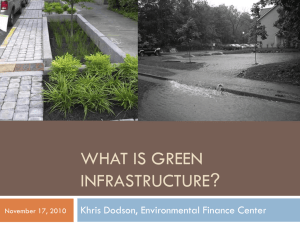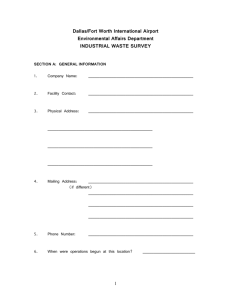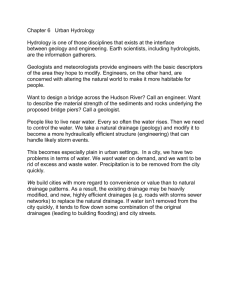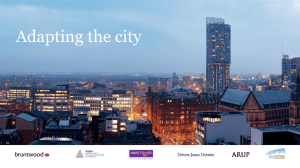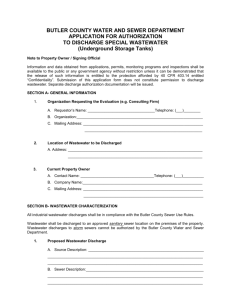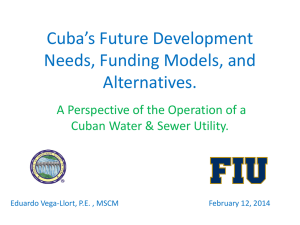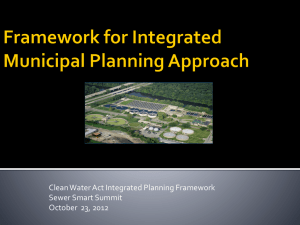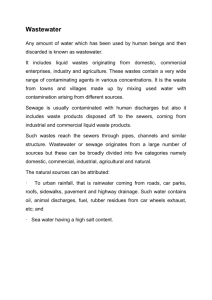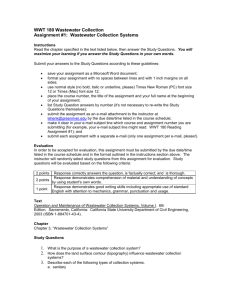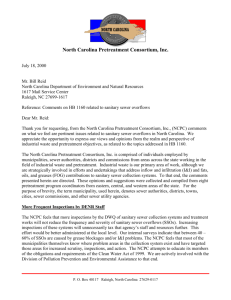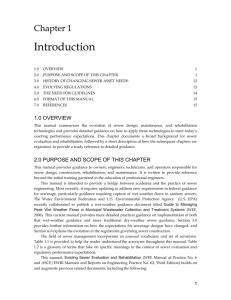SSO Comment Letter We are submitting comments in response to
advertisement
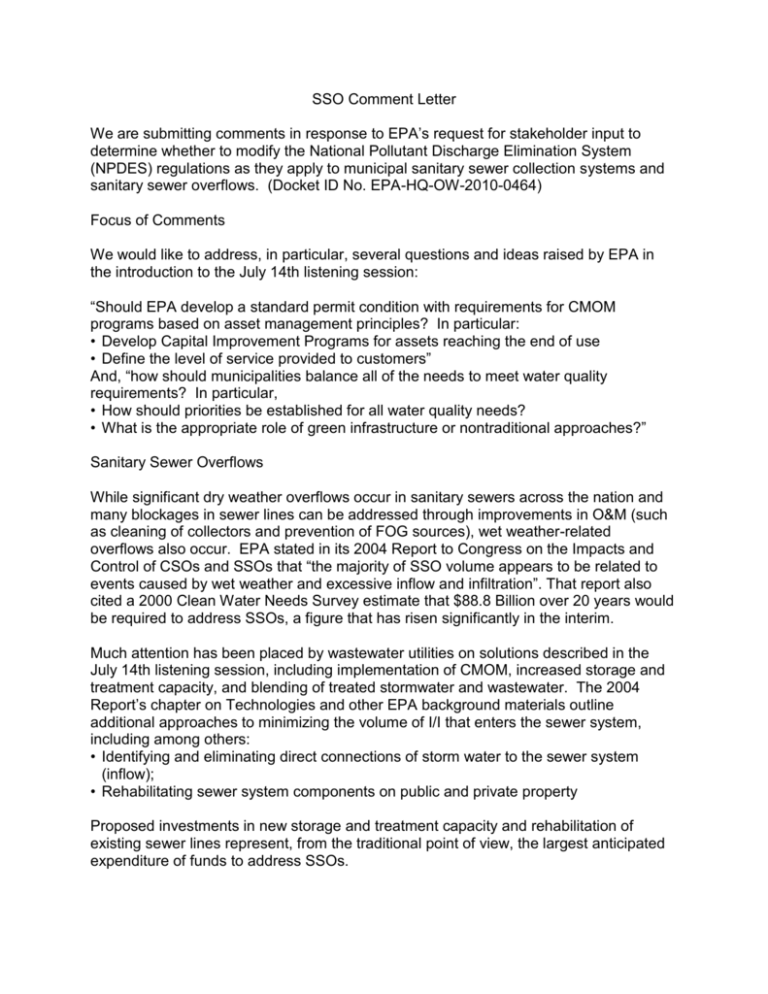
SSO Comment Letter We are submitting comments in response to EPA’s request for stakeholder input to determine whether to modify the National Pollutant Discharge Elimination System (NPDES) regulations as they apply to municipal sanitary sewer collection systems and sanitary sewer overflows. (Docket ID No. EPA-HQ-OW-2010-0464) Focus of Comments We would like to address, in particular, several questions and ideas raised by EPA in the introduction to the July 14th listening session: “Should EPA develop a standard permit condition with requirements for CMOM programs based on asset management principles? In particular: • Develop Capital Improvement Programs for assets reaching the end of use • Define the level of service provided to customers” And, “how should municipalities balance all of the needs to meet water quality requirements? In particular, • How should priorities be established for all water quality needs? • What is the appropriate role of green infrastructure or nontraditional approaches?” Sanitary Sewer Overflows While significant dry weather overflows occur in sanitary sewers across the nation and many blockages in sewer lines can be addressed through improvements in O&M (such as cleaning of collectors and prevention of FOG sources), wet weather-related overflows also occur. EPA stated in its 2004 Report to Congress on the Impacts and Control of CSOs and SSOs that “the majority of SSO volume appears to be related to events caused by wet weather and excessive inflow and infiltration”. That report also cited a 2000 Clean Water Needs Survey estimate that $88.8 Billion over 20 years would be required to address SSOs, a figure that has risen significantly in the interim. Much attention has been placed by wastewater utilities on solutions described in the July 14th listening session, including implementation of CMOM, increased storage and treatment capacity, and blending of treated stormwater and wastewater. The 2004 Report’s chapter on Technologies and other EPA background materials outline additional approaches to minimizing the volume of I/I that enters the sewer system, including among others: • Identifying and eliminating direct connections of storm water to the sewer system (inflow); • Rehabilitating sewer system components on public and private property Proposed investments in new storage and treatment capacity and rehabilitation of existing sewer lines represent, from the traditional point of view, the largest anticipated expenditure of funds to address SSOs. We suggest that a redirection or reallocation of this anticipated capital investment into Smart Clean and Green 21st Century approaches be considered by cities and towns. Some of these new approaches have already emerged in a handful of cities dealing with CSOs, and others are at the forefront of wide-ranging discussions and case studies that demonstrate a new paradigm for water management more generally. Green infrastructure approaches to minimizing I/I Cities such as Philadelphia and Syracuse have begun to implement Green Infrastructure, including green roofs, green streets, rain gardens and other Low Impact Development practices, as an alternative to increasing storage capacity in combined sewer systems. These approaches to minimizing the volume of stormwater infiltration into combined sewers will also provide multiple benefits in air quality, cooling, recreational enhancements, and other public health improvements, while increasing property values. Similar approaches should be considered in dealing with SSOs. EPA’s case study from Johnson County, Kansas shows the reduction in SSOs from a program to disconnect stormwater inflow from private property. This approach needs to be combined with a green infrastructure model to retain and treat stormwater onsite, while achieving multiple other environmental, social, and economic goals. Integrated infrastructure investments Of even greater potential is the opportunity to redirect future capital expenditures from repair and replacement of existing sanitary sewers to construction of new Smart Clean Green water and resource infrastructure in urban grids. As highlighted in a WERF-EPA workshop on June 14th, “Integration: A New Framework and Strategy for Water Management in Towns and Cities”, siloed bureaucracies have driven the construction of single-purpose centralized infrastructure (such as sewer collection and treatment) to meet drinking water, wastewater, stormwater, energy, and transportation needs. To build a sustainable future, these and other services will need to be better coordinated and integrated. New approaches to water management will require integrated planning and design for drinking water, nonpotable water, wastewater, stormwater, energy, solid waste, transportation, buildings, and other systems at a variety of scales -- from green buildings to eco-neighborhoods, to whole communities, watersheds, or regions. These future smart “networks” will provide significant synergies of design, cost-savings, and positive benefits for society, such as increased green space, restoration of waterways, reduced discharge of pollutants, improved air quality, and economic development through the creation of green jobs. A birds-eye view of the new infrastructure would reveal “networks” of decentralized, repurposed, and at times hybridized systems. Some of the innovative treatment, conservation and efficiency, and resource recovery technologies would be “embedded” in subdivisions, apartment complexes, or individual homes and offices. Other functions would be taken over by vegetative “green infrastructure”, such as green roofs and walls, trees, and grassy swales along roads and restored streams, riparian areas, and wetlands. Water and sewer lines might be rehabilitated and repurposed for reclaimed water distribution, water storage and recreation, and heat recovery. Monitoring and control technologies would be key elements in managing these systems and in protecting public health and the environment. These engineered and green networks mimic the natural systems of nodes and links in nature, where water both recycles and supports life at a local scale, but also is a linkage and transport mechanism across a landscape and into the atmosphere. Adopting these systems in cities and towns can cost less to provide water and sanitation services than current approaches and can also add significant benefits in terms of reduced resource demand, reduced pollutant discharge, air quality, energy savings and production, recreation, beauty and aesthetics, increased property values, and jobs. Innovative pricing, incentives, and new performance-based regulatory mechanisms will be required to ensure that these ecologically and socially sustainable practices are economically sustainable and are readily adoptable and that the remaining watershed and global “externalities” are also addressed by developers, homeowners, industries, and municipalities. For example, an “eco-block” incorporating architectural innovations, wind and solar power, green roof and wall cooling, rainwater harvesting, water reuse and energy recovery, and nutrient recycling into community gardens, can be nearly “off-the-grid” in regard to both energy and water, and can be located at transportation “hubs”. These new designs of infrastructure may cost less in dollars and will both improve the quality of life in urban communities and begin to protect and restore the ecological Commons. Paralleling the shift in technologies will be a shift in the institutions and markets for resource management. Municipal utilities evolved for each single-service “monopoly” in the form of separate centralized systems for water supply, stormwater transmission, and wastewater collection, treatment, and discharge (and in some cases energy generation/distribution). Embedded and green infrastructure “nodes” in homes, subdivisions, and commercial establishments should engage a wide range of private firms, non-profit groups, and other city agencies (such as parks and recreation, housing, job training, etc), and the developer and property-owner will have many more choices to meet these performance goals via new technologies, designs, and management services. Municipalities and other local governments must anticipate more complex and highlyproductive new roles in coordinating municipal utilities and agencies internally and in overseeing the new private and non-profit services through ordinances, incentives, education, and inspections. Investment dollars will flow not only from rate and tax payers but also from private capital flows brought to the table by builders and entrepreneurs who are leading the green building revolution. Innovation and Adaptive Management Frameworks USEPA Administrator Jackson recently called for a national recommitment to clean water. At a "Coming Together for Clean Water" summit on April 15th, the Administrator described the necessity for innovation, saying that "Stronger protections are going to have to be met with new ideas and cost-effective strategies. If we want our waters to work harder, we have to work smarter." Jackson also stated the need for broad community engagement, greater public outreach and education, and collaboration with industry, advocacy, and engineering. Recent strategic frameworks in the Chesapeake Bay Program (CBP) reflect these new commitments by the Agency. The CBP has specifically adopted an Adaptive Management Model, which establishes strong relationships between strategy and operations and "fosters continual improvement of both Bay implementation activities and CBP's organizational performance. The cycle of active strategy development, planning, implementation, and evaluation is to be applied to all areas of CBP activity so that the organization itself, not only individual partners or partners engaged in on-theground implementation, will learn and change based on the outputs of the adaptive management process." New Water Management Paradigm The emerging concepts and case studies in Smart Clean and Green water management and adaptive management are increasingly reflected in recent EPA, Clean Water America Alliance, Johnson Foundation at Wingspread, Aspen Institute, WERF, and other workshops. The imperatives of this future visioning for wastewater utilities are the need to explore actively a reallocation of capital expenditures into innovative 21st Century approaches and to participate fully in integrated infrastructure planning to achieve multiple environmental, social, and economic goals and objectives in cities and towns. The crisis of aging infrastructure in the U.S. can be seen as an opportunity in this regard. The fact that the nation’s sewer infrastructure has deteriorated so badly provides the opening to extend the life of or outright abandon existing systems (run to failure) and consider a pivoting of investments into new and more sustainable approaches. For example, satellite treatment and reuse of wastewater and stormwater could be built to reduce the demand for potable water while reducing flows in sanitary sewers. The City of Detroit is going further by suggesting that abandoned neighborhoods be rebuilt only with local water sources, reuse, and treatment. Asset Management and Levels of Service One promising approach for streaming in Smart Clean and Green integrated infrastructure innovations is through an expansion of “Levels of Service” expected of utilities. In a 2007 workshop, Steve Allbee from USEPA attempted to broaden the “key characteristics of sustainable utilities” to include concepts such as “Sustainable Objectives set for Economic, Social, and Environmental” concerns (triple bottom line management), and “Stewardship of the Total Water Cycle.” A 2007 report developed by the EPA and six other national utility organizations (Effective Utility Management Steering Committee) references the following additional levels of service to be considered, including: integration of alternative, watershedbased approaches to potentially reduce future infrastructure costs (e.g. centralized management of decentralized systems, smart growth strategies, source water protection programs, low-impact development, etc.); promotion of Green Building and related water conservation strategies; consideration of tangible benefits to the community, such as neighborhood improvements; and provision for stakeholder input into the utility’s decision making and priority setting. We support an expansion of Levels of Service to incorporate these and other sustainability goals responsive to the multiple challenges of water shortages, climate change, nutrient and toxic chemical pollution, phosphorus depletion, loss of ecosystem services, and others. We also encourage the inclusion of adaptive management or continuous learning requirements in the asset management framework. Private companies typically invest in research and development and so should municipal utilities. In this regard, we encourage EPA to work with local utilities to access the CWSRF “green project reserve” to begin piloting of green infrastructure and environmentally innovative approaches. We also suggest the inclusion of required “integrated water management plans” as a precondition for CWSRF funding of SSO remediation plans. Finally, we suggest that guidelines under development for permitting green infrastructure components of long-term CSO control plans also be adopted in new SSO permitting approaches. We look forward to discussing further these promising opportunities for achieving sustainability in the nation’s sewer and water infrastructure. Sincerely, Valerie Nelson Coalition for Alternative Wastewater Treatment valerie.i.nelson@gmail.com Paul Schwartz Clean Water Action Rich Sustich Trustee, Village of Lake Zurich, IL Emeritus Member, National Advisory Council for Environmental Planning and Technology Ed Clerico Alliance Environmental Jim Kriessl Independent Consultant Vicki Elmer and Elizabeth Deatin University of California - Berkeley Former EPA wastewater expert Glen Daigger CH2MHill President, International Water Association
